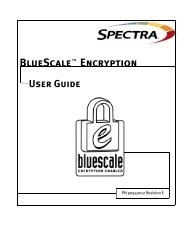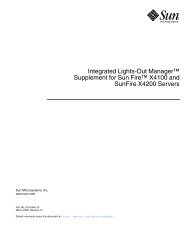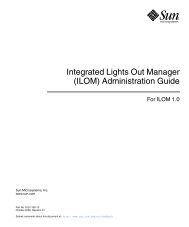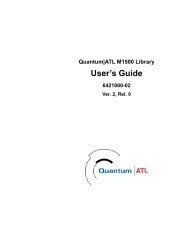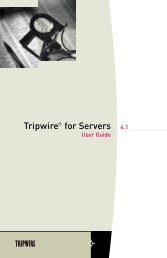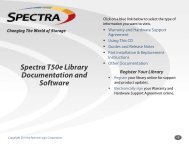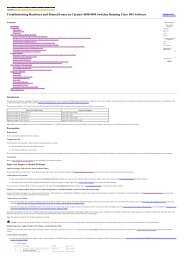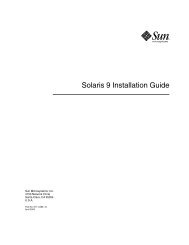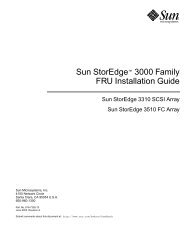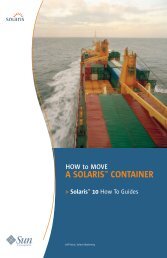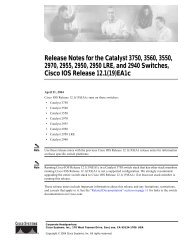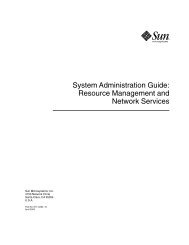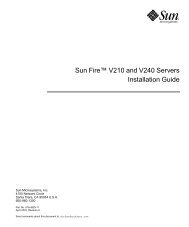Sun StorEdge SRC/P Intelligent SCSI RAID ControllerTM System ...
Sun StorEdge SRC/P Intelligent SCSI RAID ControllerTM System ...
Sun StorEdge SRC/P Intelligent SCSI RAID ControllerTM System ...
Create successful ePaper yourself
Turn your PDF publications into a flip-book with our unique Google optimized e-Paper software.
<strong>Sun</strong> <strong>StorEdge</strong> <strong>SRC</strong>/P<br />
<strong>Intelligent</strong> <strong>SCSI</strong> <strong>RAID</strong><br />
Controller TM <strong>System</strong><br />
Just the Facts
Copyrights<br />
©1999 <strong>Sun</strong> Microsystems, Inc. All Rights Reserved.<br />
<strong>Sun</strong>, <strong>Sun</strong> Microsystems, the <strong>Sun</strong> logo, <strong>Sun</strong> <strong>StorEdge</strong>, <strong>Sun</strong> <strong>StorEdge</strong> <strong>SRC</strong>/P <strong>Intelligent</strong> <strong>SCSI</strong> Raid<br />
Controller, <strong>Sun</strong> Enterprise, <strong>Sun</strong> <strong>StorEdge</strong> <strong>SRC</strong>/P Storage Manager, Solaris, Solstice DiskSuite, <strong>Sun</strong>VTS,<br />
OpenBoot, <strong>Sun</strong> Enterprise SyMON, <strong>Sun</strong> Enterprise Ultra, <strong>Sun</strong>Spectrum, <strong>Sun</strong>Spectrum Platinum,<br />
<strong>Sun</strong>Spectrum Gold, <strong>Sun</strong>Spectrum Silver, <strong>Sun</strong>Spectrum Bronze, <strong>Sun</strong>VIP, <strong>Sun</strong>Solve, and <strong>Sun</strong>Solve<br />
EarlyNotifier are trademarks, registered trademarks, or service marks of <strong>Sun</strong> Microsystems, Inc. in the<br />
United States and other countries.<br />
UNIX is a registered trademark in the United States and other countries, exclusively licensed through<br />
X/Open Company, Ltd.<br />
Just the Facts December 1999
Introduction<br />
Positioning<br />
In the highly competitive enterprise workgroup server market, a large and growing proportion of<br />
performance-sensitive customers are taking advantage of low-cost hardware <strong>RAID</strong> storage controller cards<br />
to improve the data availability, system throughput, and price/performance of their distributed application<br />
servers and database servers. Hardware <strong>RAID</strong> controllers are an economical way for customers to improve<br />
data security and availability without suffering the performance penalty imposed by host-based software<br />
<strong>RAID</strong>. They also deliver controller-based <strong>RAID</strong> performance advantages economically and space<br />
efficiently, by providing <strong>RAID</strong> functionality via the host systems’ internal <strong>SCSI</strong> disk drives instead of<br />
external storage arrays.<br />
The economy and performance advantages offered by hardware <strong>RAID</strong> controllers is so widely accepted in<br />
the server market that many customers consider hardware <strong>RAID</strong> an absolute requirement for their server<br />
purchases. <strong>Sun</strong> recognizes the growing customer demand for low-cost hardware <strong>RAID</strong> capability for<br />
workgroup servers and has responded to this need by introducing the <strong>Sun</strong> <strong>StorEdge</strong> <strong>SRC</strong>/P <strong>Intelligent</strong><br />
<strong>SCSI</strong> <strong>RAID</strong> Controller TM system (<strong>SRC</strong>/P).<br />
What is Supported as of November 30, 1999?<br />
As of November 30, 1999, supported configurations include <strong>SRC</strong>/P support for:<br />
• Up to 16 internal drives on the <strong>Sun</strong> EnterpriseTM 450 server<br />
• Up to 18 <strong>Sun</strong> <strong>StorEdge</strong>TM MultiPack devices on the <strong>Sun</strong> Enterprise 450 server<br />
• Up to 9 <strong>Sun</strong> <strong>StorEdge</strong> MultiPack devices on the <strong>Sun</strong> Enterprise 250 server<br />
What is Not Supported as of November 30, 1999?<br />
As of November 30, 1999, all 20 internal drives on the <strong>Sun</strong> Enterprise 450 server are not controllable by<br />
<strong>SRC</strong>/P. Internal drives on the <strong>Sun</strong> Enterprise 250 server are not controllable by <strong>SRC</strong>/P. The reason that this<br />
level of support is not offered is that the drivers for booting from an internal device controlled by <strong>SRC</strong>/P<br />
are not currently available as of November 30, 1999.<br />
When Will Internal Boot Support with <strong>SRC</strong>/P be Available?<br />
As of November 30, 1999, the target date for announcing internal boot support is the beginning of calendar<br />
year 2000.<br />
Product Overview<br />
The <strong>Sun</strong> <strong>StorEdge</strong> <strong>SRC</strong>/P <strong>Intelligent</strong> <strong>SCSI</strong> <strong>RAID</strong> Controller (<strong>SRC</strong>/P) system is a high-performance disk<br />
storage controller for <strong>Sun</strong> Enterprise 250 and 450 workgroup servers. It gives <strong>Sun</strong>’s workgroup server<br />
customers the performance and data protection advantages of the latest <strong>RAID</strong> storage technology for a very<br />
attractive price. This system supports non-<strong>RAID</strong> <strong>SCSI</strong> disk operations as well as <strong>RAID</strong> levels 0, 1, 1+0, 5,<br />
and 5+0.<br />
This 64-bit PCI card supports internal Ultra<strong>SCSI</strong> disk drives or external <strong>Sun</strong> <strong>StorEdge</strong> MultiPack storage<br />
units on each of three 40 MB per second <strong>SCSI</strong> channels. Its powerful on-board microprocessor offloads<br />
many routine storage I/O operations and all <strong>RAID</strong> management activities from the host system, enabling<br />
Just the Facts December 1999<br />
Positioning
the host system CPUs to do more productive work. In addition, its 64 MB of on-board, battery-protected,<br />
data cache memory and intelligent caching algorithms speed up many disk read and write operations,<br />
reducing system response time and increasing overall throughput.<br />
The <strong>Sun</strong> <strong>StorEdge</strong> <strong>SRC</strong>/P <strong>Intelligent</strong> <strong>SCSI</strong> <strong>RAID</strong> Controller system will be offered in three standard<br />
configurations:<br />
• The first option supports the <strong>Sun</strong> Enterprise 450 server’s internal disks. It includes the <strong>Sun</strong> <strong>StorEdge</strong><br />
<strong>SRC</strong>/P controller, an eight-slot disk backplane, internal cables, and the <strong>Sun</strong> <strong>StorEdge</strong> <strong>SRC</strong>/P software.<br />
Two of these options will support up to 16 internal disks. Once announced, an optional third internal<br />
<strong>SCSI</strong> bus cable will allow one <strong>SRC</strong>/P controller option will support 12 internal disks (in the four<br />
standard drive bays plus eight option bays), allowing all 20 internal drives to be supported in <strong>RAID</strong><br />
arrays. (Note: Installation of a third internal <strong>SCSI</strong> bus cable will not be supported on the <strong>Sun</strong> Enterprise<br />
450 server at GA.)<br />
• Once announced, a second option will support <strong>Sun</strong> Enterprise 250 server internal disks. This option will<br />
include the controller, <strong>Sun</strong> Enterprise 250 server internal cables, <strong>Sun</strong> <strong>StorEdge</strong> <strong>SRC</strong>/P software, and<br />
two external <strong>SCSI</strong> cables. The system’s six internal drives will be supported by one of the controller’s<br />
<strong>SCSI</strong> channel, while the remaining channels can be used to support <strong>Sun</strong> <strong>StorEdge</strong> MultiPack storage.<br />
(Note: Internal drive support on the <strong>Sun</strong> Enterprise 250 server will not be available at GA.)<br />
• The third option can be used to support <strong>Sun</strong> <strong>StorEdge</strong> MultiPack storage units on all three controller<br />
channels. Up to six of these options can be supported on the <strong>Sun</strong> Enterprise 450 server, providing up to<br />
2 TB of high performance <strong>RAID</strong> storage capacity. Up to three <strong>Sun</strong> <strong>StorEdge</strong> <strong>SRC</strong>/P controllers can be<br />
supported on the <strong>Sun</strong> Enterprise 250 server, for a maximum <strong>RAID</strong> storage capacity of 1 TB. This <strong>Sun</strong><br />
<strong>StorEdge</strong> <strong>SRC</strong>/P option will also support <strong>Sun</strong> <strong>StorEdge</strong> MultiPack storage on future <strong>Sun</strong> workgroup<br />
servers.<br />
Just the Facts December 1999<br />
Positioning
Internal 68-pin <strong>SCSI</strong> connectors<br />
External high-density 68-pin<br />
<strong>SCSI</strong> connectors<br />
64-MB data<br />
cache memory<br />
Reverse View<br />
Front View<br />
64-bit PCI connector<br />
Figure 1. <strong>Sun</strong> <strong>StorEdge</strong> <strong>SRC</strong>/P <strong>Intelligent</strong> <strong>SCSI</strong> <strong>RAID</strong> Controller system physical views<br />
<strong>Sun</strong> <strong>StorEdge</strong> <strong>SRC</strong>/P Storage Manager TM Software<br />
NiMH Batteries<br />
and charger<br />
The <strong>Sun</strong> <strong>StorEdge</strong> <strong>SRC</strong>/P <strong>Intelligent</strong> <strong>SCSI</strong> <strong>RAID</strong> Controller system comes with device drivers for<br />
Solaris TM 2.6 and Solaris 7 Operating Environments, controller operating firmware, and a controller<br />
management interface, called <strong>Sun</strong> <strong>StorEdge</strong> <strong>SRC</strong>/P Storage Manager TM software. The <strong>Sun</strong> <strong>StorEdge</strong> <strong>SRC</strong>/P<br />
Just the Facts December 1999<br />
Positioning
Storage Manager software provides an easy to use graphical interface for installing, configuring, and<br />
managing <strong>SRC</strong>/P <strong>RAID</strong> storage. With the <strong>Sun</strong> <strong>StorEdge</strong> <strong>SRC</strong>/P Storage Manager software, system<br />
administrators can:<br />
• Setup <strong>Sun</strong> <strong>StorEdge</strong> <strong>SRC</strong>/P controllers and their disks<br />
• Flash update controller firmware<br />
• Verify proper controller, cabling, and disk installation and operation<br />
• Create, configure, and delete <strong>RAID</strong> 0, 1, or 5 arrays or <strong>RAID</strong> 1+0 or 5+0 array groups<br />
• Designate a hot spare disk and set up the controller to automatically recover any supported <strong>RAID</strong> 1,<br />
1+0, 5, or 5+0 array from a disk failure<br />
• Set and change controller caching policies for each <strong>RAID</strong> array<br />
• Monitor disk and controller status and view event logs<br />
• Review performance data collected by the <strong>Sun</strong> <strong>StorEdge</strong> <strong>SRC</strong>/P controller<br />
• View the status of the memory battery backup unit and run periodic battery maintenance routines<br />
• Manually restore an array after a disk failure<br />
• Swap out a failed drive and install a replacement disk<br />
The <strong>Sun</strong> <strong>StorEdge</strong> <strong>SRC</strong>/P Storage Manager runs on the host server and can display output on the system<br />
local graphics console or on a network attached X-windows graphical display. A single <strong>Sun</strong> <strong>StorEdge</strong><br />
<strong>SRC</strong>/P Storage Manager instance can manage all <strong>Sun</strong> <strong>StorEdge</strong> <strong>SRC</strong>/P controllers in the system.<br />
In addition to the graphical interface, <strong>Sun</strong> <strong>StorEdge</strong> <strong>SRC</strong>/P Storage Manager software provides a Solaris<br />
Operating Environment command line interface.<br />
<strong>Sun</strong> <strong>StorEdge</strong> <strong>SRC</strong>/P Controller <strong>System</strong> Features and Benefits<br />
Features Benefits<br />
• PCI 2.1 compliant, PCI card with long<br />
form factor, single PCI slot width<br />
(including battery pack)<br />
• Fits in any 64-bit PCI slot in <strong>Sun</strong> Enterprise 250 or<br />
450 servers<br />
• 64-bit, 33-MHz PCI card • Fits in any 64-bit PCI slot in <strong>Sun</strong> Enterprise 250 or<br />
450 servers<br />
• Supports 64-bit PCI transfers • Fast data transfers to memory<br />
• 264 MB/sec. maximum PCI data transfer<br />
rate<br />
• Efficient use of the PCI bus bandwidth<br />
• Three independent single-ended<br />
Ultra<strong>SCSI</strong> buses<br />
• Configuration flexibility<br />
– Each bus will support either internal or<br />
external devices (not both)<br />
– 40 MB/sec. peak throughput per bus • Meets or exceeds the capabilities of the supported<br />
disk drives<br />
– Three internal ultra-wide (40 MB/sec.)<br />
ports (one on each <strong>SCSI</strong> bus)<br />
• Can support up to 12 internal disks in <strong>Sun</strong><br />
Enterprise 450 server or 6 internal drives in <strong>Sun</strong><br />
Enterprise 250 server<br />
Just the Facts December 1999<br />
Positioning
Features Benefits<br />
– Three external <strong>SCSI</strong>-3 (F/W capable)<br />
ports (one on each channel);<br />
auto-negotiated port speeds<br />
• Supports single-ended Ultra<strong>SCSI</strong> <strong>SCSI</strong><br />
disks (F/W <strong>SCSI</strong> drives supported in <strong>Sun</strong><br />
<strong>StorEdge</strong> MultiPack systems)<br />
• On-board microprocessor handles all disk<br />
I/O<br />
• Provides hardware acceleration for <strong>RAID</strong><br />
0, 1, 1+0, 5, and 5+0<br />
• Supports independent disks and different<br />
<strong>RAID</strong> levels for different drives and drives<br />
groups attached to the same controller<br />
• 64-MB, on-board, ECC-protected I/O data<br />
cache memory (additional memory slots<br />
on the board are not supported at this time)<br />
• Implements read-ahead and predictive<br />
caching<br />
• Cache can be set for write-through or<br />
write-back modes of operation<br />
• Online switching of cache management<br />
policies (WB, WT)<br />
• No rebooting required after changes to<br />
cache management policies<br />
• On-board battery backup provides 48 hour<br />
cache memory data protection<br />
• On-board battery charger plus fast<br />
recharge batteries, maximum three hour<br />
recharge time<br />
• Battery monitor with<br />
battery-low/battery-fail indicator<br />
• Supports up to three <strong>Sun</strong> <strong>StorEdge</strong> MultiPack disk<br />
systems with either 7200-rpm F/W or Ultra<strong>SCSI</strong><br />
drives<br />
• Compatible with internal Ultra<strong>SCSI</strong> disk drives<br />
and <strong>Sun</strong> <strong>StorEdge</strong> MultiPack disk storage systems<br />
• Provides excellent storage capacity and<br />
performance for low cost/MB<br />
• Significantly reduces system overhead for disk<br />
intensive workloads; frees main system CPUs to<br />
do productive work<br />
• Supports all of the popular <strong>RAID</strong> levels, for<br />
performance and data availability<br />
• Makes it easy to optimize storage for multiple<br />
concurrent applications<br />
• Makes it easy to match data layouts to meet users’<br />
specific requirements for capacity, performance,<br />
high availability, and cost<br />
• Large-capacity, dedicated data cache memory<br />
supports high performance I/O; ECC protection<br />
provides data integrity<br />
• Boosts system read performance<br />
• Write-through mode provides maximum data<br />
protection; write-back mode significantly<br />
accelerates disk write operations<br />
• The ability to switch from write-back to<br />
write-through mode online enables data integrity if<br />
the battery charge is low without disrupting system<br />
operation<br />
• Battery backup protects write data cached in the<br />
controller against power failure; enables faster data<br />
I/O with full data protection<br />
• Allows quicker returns to write-back mode of<br />
operation after battery discharges, accelerating<br />
system performance<br />
• Alerts system manager to change cache policy to<br />
write-through mode when battery-backup is<br />
compromised<br />
Just the Facts December 1999<br />
Positioning
Features Benefits<br />
• Controller installation, configuration, and<br />
management is handled through <strong>Sun</strong><br />
<strong>StorEdge</strong> <strong>SRC</strong>/P Storage Manager<br />
software<br />
– Simple graphical X-windows interface<br />
– Solaris Operating Environment<br />
command line interface<br />
• Unbundled software release CD (at GA)<br />
– Device driver for Solaris 2.6 and 7<br />
Operating Environments<br />
– Host system firmware update<br />
– Controller firmware<br />
– <strong>Sun</strong> <strong>StorEdge</strong> <strong>SRC</strong>/P Storage Manager<br />
software<br />
– Installation and user documentation<br />
• Solstice DiskSuite TM or VERITAS Volume<br />
Manager software can be used to<br />
create/manage arrays that span two or<br />
more <strong>Sun</strong> <strong>StorEdge</strong> <strong>SRC</strong>/P controllers or<br />
other arrays<br />
• <strong>Sun</strong> <strong>StorEdge</strong> <strong>SRC</strong>/P arrays can span<br />
drives on all three controller channels<br />
• <strong>RAID</strong> stripe sizes are adjustable to<br />
optimize for random or sequential I/O<br />
patterns<br />
• <strong>Sun</strong> <strong>StorEdge</strong> <strong>SRC</strong>/P Storage Manager software<br />
makes setting up and managing <strong>RAID</strong> arrays fast<br />
and easy, even for non-UNIX ® administrators<br />
• Improves system/data availability by eliminating<br />
controllers as single points of failure<br />
• All attached storage (internal disks and external<br />
arrays) can be managed in a uniform fashion<br />
through a common interface<br />
• Improves system throughput and response time<br />
under heavy workloads<br />
• Improves system/data availability by eliminating<br />
<strong>SCSI</strong> buses, cables, and disk backplanes/drive<br />
enclosures as single points of failure<br />
• Users can tune for best performance for their<br />
specific applications<br />
• Support for online <strong>RAID</strong> reconfiguration • <strong>System</strong> managers have the flexibility of adapting<br />
storage to changing needs without disrupting<br />
system services<br />
• Support for hot sparing<br />
• The <strong>Sun</strong> <strong>StorEdge</strong> <strong>SRC</strong>/P controller can<br />
• Hot spare is automatically swapped in to<br />
replace any failed disk in a <strong>RAID</strong>-1, 1+0,<br />
5, or 5+0 <strong>RAID</strong> group<br />
automatically failover to the hot spare drive and<br />
rebuild any <strong>RAID</strong> 1, 1+0, 5, or 5+0 array, quickly<br />
returning the system to peak performance after a<br />
drive failure without any interruption to system<br />
services<br />
• Continuous redundant data protection even if a<br />
disk fails<br />
• Schedulable drive rebuilds • Allows system managers greater flexibility in<br />
delivering system services; rebuilds can be<br />
deferred to off-peak hours<br />
• Support for drive hot swapping • Failed drives can be replaced without disrupting<br />
system services<br />
Just the Facts December 1999<br />
Positioning
Features Benefits<br />
• Support for online physical drive<br />
migration<br />
• Controller firmware downloadable/flash<br />
upgradeable from the host system using<br />
<strong>Sun</strong> <strong>StorEdge</strong> <strong>SRC</strong>/P Storage Manager<br />
• Power-on self test; support for OpenBoot TM<br />
diagnostics and <strong>Sun</strong>VTS TM<br />
• Supported by <strong>Sun</strong>TM Management Center<br />
(formerly <strong>Sun</strong> Enterprise SyMONTM )<br />
software<br />
• Performance monitoring and data logging<br />
• On-line drive fault detection and reporting<br />
• Event logging<br />
• Online drive testing (new drives)<br />
• <strong>RAID</strong> configuration written through to the<br />
disks, rather than stored in the controller<br />
• On-board NVRAM for storing controller<br />
configurationinformation<br />
<strong>Sun</strong> <strong>StorEdge</strong> <strong>SRC</strong>/P <strong>Intelligent</strong> <strong>SCSI</strong> <strong>RAID</strong> Controller Target Markets<br />
– <strong>Sun</strong> direct end-user customers and reseller customers (all Geos)<br />
– <strong>Sun</strong> Enterprise 250 and 450 workgroup server customers<br />
– Small- to medium-scale database servers, file servers, and transaction-oriented business application<br />
servers (CMS, ERP, e-commerce)<br />
– All industries, government, and educational institutions<br />
Product Availability<br />
• Allows healthy drives to be relocated to a new<br />
drive bay to reduce system downtime<br />
• Easy to keep firmware up to the latest revision<br />
• Enables fast, easy problem identification and<br />
diagnosis for maximum system uptime<br />
• Easy to restore full operation if the <strong>Sun</strong> <strong>StorEdge</strong><br />
<strong>SRC</strong>/P controller is swapped out; arrays remain<br />
intact and data is quickly accessible<br />
• Easy to restore full operation quickly after a<br />
system shutdown or power failure; no need to<br />
manually restore all controller settings<br />
General Availability (GA) for the X-options for this product is May 25, 1999. The configured options will<br />
not be available until early Q1FY00.<br />
Just the Facts December 1999<br />
Positioning
Price / MB<br />
Workgroup<br />
<strong>SCSI</strong> adapter<br />
Product Family Positioning<br />
<strong>SRC</strong>/P<br />
A1000<br />
A3500<br />
A5000<br />
Storage Capacity, RAS<br />
The <strong>Sun</strong> <strong>StorEdge</strong> <strong>SRC</strong>/P <strong>Intelligent</strong> <strong>SCSI</strong> <strong>RAID</strong> Controller system fits into the <strong>Sun</strong> workgroup server<br />
storage product lineup between host-controlled internal Ultra<strong>SCSI</strong> disks and the <strong>Sun</strong> <strong>StorEdge</strong> A1000<br />
<strong>RAID</strong> storage array.<br />
<strong>Sun</strong> <strong>StorEdge</strong> <strong>SRC</strong>/P Versus Ultra<strong>SCSI</strong> Host Bus Adapter<br />
With its 64 MB of battery-protected data cache memory and intelligent caching algorithms, the <strong>Sun</strong><br />
<strong>StorEdge</strong> <strong>SRC</strong>/P <strong>Intelligent</strong> <strong>SCSI</strong> <strong>RAID</strong> Controller (<strong>SRC</strong>/P) system provides significantly greater disk I/O<br />
throughput than simple <strong>SCSI</strong> host bus adapters for nearly any application. When disk striping is required to<br />
boost system performance under heavy loads, the performance advantages of the <strong>SRC</strong>/P system’s hardware<br />
<strong>RAID</strong> become even more pronounced. In addition, with three disk I/O channels per card, the <strong>Sun</strong> <strong>StorEdge</strong><br />
<strong>SRC</strong>/P controller can deliver more disk IOPS (I/O transfers per second) and more total data throughput per<br />
PCI slot than any available single or dual channel controller cards—even more than Fibre Channel.<br />
<strong>Sun</strong> <strong>StorEdge</strong> <strong>SRC</strong>/P Versus <strong>Sun</strong> <strong>StorEdge</strong> A1000 Array<br />
A7000<br />
Data Center<br />
For many <strong>RAID</strong> applications, the <strong>Sun</strong> <strong>StorEdge</strong> <strong>SRC</strong>/P controller offers equal or higher disk I/O<br />
performance than the <strong>Sun</strong> <strong>StorEdge</strong> A1000 array. By placing the <strong>RAID</strong> controller intelligence on the PCI<br />
bus instead of at the other end of the <strong>SCSI</strong> bus, the <strong>Sun</strong> <strong>StorEdge</strong> <strong>SRC</strong>/P controller reduces the hand-off<br />
time and latency for host data read requests. This design also reduces the number of request and data<br />
handling steps in retrieving data from the disks, thus further reducing read latency. Likewise, since the<br />
controller’s write cache memory is closer to the host system bus, write latency for write-back operations is<br />
also reduced.<br />
For customers whose total storage requirements can be met by the internal drives of the <strong>Sun</strong> Enterprise 250<br />
or 450 server, the <strong>Sun</strong> <strong>StorEdge</strong> <strong>SRC</strong>/P controller eliminates the need to find space for an external storage<br />
box. It also reduces cost by eliminating the need for components such as external enclosures, power<br />
supplies, and fans. For many workgroup server applications, the <strong>Sun</strong> <strong>StorEdge</strong> <strong>SRC</strong>/P controller offers<br />
higher performance and a lower cost per megabyte than the <strong>Sun</strong> <strong>StorEdge</strong> A1000 array.<br />
The <strong>Sun</strong> <strong>StorEdge</strong> A1000 array is the answer for customers who require clustered servers with shared<br />
access to storage. The <strong>Sun</strong> <strong>StorEdge</strong> <strong>SRC</strong>/P controller does not at present support multihost access to<br />
shared disks; the <strong>Sun</strong> <strong>StorEdge</strong> A1000 array, supported by <strong>Sun</strong> TM Cluster 2.1 software, does. In addition,<br />
Just the Facts December 1999<br />
Positioning
even with clustering supported, the <strong>Sun</strong> <strong>StorEdge</strong> <strong>SRC</strong>/P controller could only operate in write-through<br />
mode when disks are shared between two controllers. This is necessary in order to maintain complete data<br />
integrity in the event of a power failure. This restriction significantly reduces overall disk I/O performance<br />
for write-intensive applications. Since the <strong>Sun</strong> <strong>StorEdge</strong> A1000 array controller and write cache are shared<br />
by both host systems, the problems associated with maintaining cache data integrity when operating in<br />
write-back mode are eliminated.<br />
The <strong>Sun</strong> <strong>StorEdge</strong> A1000 array also offers a better solution for customers who need to store large amounts<br />
of data (greater than 1 TB). Since the <strong>Sun</strong> <strong>StorEdge</strong> <strong>SRC</strong>/P controller only supports single-ended <strong>SCSI</strong><br />
devices, Ultra<strong>SCSI</strong>-capable <strong>Sun</strong> <strong>StorEdge</strong> MultiPack systems must be no more than two meters from the<br />
host server. Physical placement of more than nine <strong>Sun</strong> <strong>StorEdge</strong> MultiPack systems within such close<br />
proximity to the server can be challenging.<br />
Detailed Product Comparison<br />
Features Dual Ultra<strong>SCSI</strong> +<br />
<strong>Sun</strong> <strong>StorEdge</strong><br />
MultiPack<br />
Host bus adapter type 32-bit, 33-MHz<br />
PCI<br />
<strong>Sun</strong> <strong>StorEdge</strong><br />
<strong>SRC</strong>/P<br />
Controller<br />
64-bit, 33-MHz<br />
PCI<br />
<strong>Sun</strong> <strong>StorEdge</strong><br />
A1000 Array<br />
32-bit, 33-MHz<br />
PCI<br />
<strong>Sun</strong> <strong>StorEdge</strong><br />
A5000 Array<br />
64-bit, 33-MHz<br />
PCI<br />
Max. host bus (PCI) I/O data rate 132 MB/sec. 264 MB/sec. 132 MB/sec. 264 MB/sec.<br />
# Disk I/O buses per HBA 2 3 2 1<br />
Disk I/O bus type Single-ended Single-ended Differential Fibre Channel<br />
Ultra<strong>SCSI</strong> Ultra<strong>SCSI</strong> Ultra<strong>SCSI</strong><br />
Disk I/O bus data rate, max. 40 MB/sec. 40 MB/sec. 40 MB/sec. 100 MB/sec.<br />
HBA data throughput, max. 80 MB/sec. 120 MB/sec. 80 MB/sec. 100 MB/sec.<br />
Max. # drives per disk I/O bus 6@40 MB/sec. 6@40 MB/sec. 24@40 MB/sec. 66<br />
12@20 MB/sec. 12@20 MB/sec.<br />
Max. # drives per HBA 12@40 MB/sec. 18@40 MB/sec. 48@40 MB/sec. 66<br />
24@20 MB/sec. 36@20 MB/sec.<br />
Max. storage capacity per HBA 2 x 6 x 18 GB = 3 x 6 x 18 GB = 4 x 8 x 18 GB = 4 x 14 x 18 =<br />
216 GB<br />
324 GB 576 GB<br />
1008 GB<br />
Max. HBAs per <strong>Sun</strong> Enterprise 450<br />
server<br />
10 6 7 4<br />
<strong>Sun</strong> Enterprise 450 server max. raw<br />
disk I/O bandwidth<br />
584 MB/sec. 690 MB/sec. 532 MB/sec. 400 MB/sec.<br />
Max. drives per <strong>Sun</strong> Enterprise 450<br />
server<br />
120@40 MB/sec. 126@40 MB/sec. 168@40 MB/sec. 132<br />
Max. storage capacity per <strong>Sun</strong><br />
Enterprise 450 server<br />
2.2 TB 2.3 TB 2.0 TB 2.0 TB<br />
List price/GB @100 GB US$120 US$157 US$174 US$514<br />
List price/GB @200 GB US$115 US$142 US$169 US$484<br />
Max. HBAs per <strong>Sun</strong> Enterprise 250<br />
server<br />
4 3 4 2<br />
<strong>Sun</strong> Enterprise 250 server max. raw<br />
disk I/O bandwidth<br />
212 MB/sec. 333 MB/sec. 212 MB/sec. 200 MB/sec.<br />
Max. drives per <strong>Sun</strong> Enterprise 250<br />
server<br />
48@40 MB/sec. 72@40 MB/sec. 96@40 MB/sec. 66<br />
Just the Facts December 1999<br />
Positioning
Features Dual Ultra<strong>SCSI</strong> +<br />
<strong>Sun</strong> <strong>StorEdge</strong><br />
MultiPack<br />
Max. storage capacity per <strong>Sun</strong><br />
Enterprise 250 server<br />
<strong>RAID</strong>-0 performance (6 drive<br />
stripes, 12 drives total)<br />
864 GB 1.3 TB 1.2 TB 1.0 TB<br />
• 64-KB seq. read (MB/sec.) — — — —<br />
• 64-KB seq. read (MB/sec.) — — — —<br />
<strong>RAID</strong>-5 performance (6 drive<br />
stripes, 12 drives total)<br />
• 2-KB random read (IOPS) — — — —<br />
• 2-KB random read (IOPS) — — — —<br />
• Support for system boot disk Yes TBD No No<br />
• On-board microprocessor<br />
handles all disk I/O and <strong>RAID</strong><br />
calculations<br />
No Yes Yes No<br />
• ECC and battery protected I/O<br />
data cache memory<br />
No Yes, 64 MB Yes, 16-MB<br />
upgradeable to<br />
64 MB<br />
• On-board battery backup N/A Standard Standard N/A<br />
– # hours of cache data<br />
protection<br />
48 hours 72 hours<br />
– Battery monitor with<br />
battery-low/battery-fail<br />
indicator<br />
Yes<br />
– On-board battery charger Yes<br />
– Batteries recharge time,<br />
max.<br />
3 hours<br />
Key to notations below:<br />
S = <strong>Sun</strong> <strong>StorEdge</strong> <strong>SRC</strong>/P Storage Manager<br />
V = VERITAS Volume Manager<br />
R = <strong>RAID</strong> Manager<br />
D = Solstice DiskSuite<br />
• Supported <strong>RAID</strong> managers • V or D • S or • R or<br />
• V<br />
– <strong>Sun</strong> <strong>StorEdge</strong> <strong>SRC</strong>/P<br />
Storage Manager (S)<br />
S + V or D R + V or D<br />
– <strong>RAID</strong> Manager (R)<br />
– VERITAS Volume Manager<br />
(V)<br />
– Solstice DiskSuite (D)<br />
• Supports <strong>RAID</strong> 0, 1, 1+0, 5<br />
• Supports <strong>RAID</strong> 3<br />
• Supports <strong>RAID</strong> 5+0<br />
• Supports multi-modes<br />
(different <strong>RAID</strong> levels for<br />
different drives)<br />
• V, D<br />
• No<br />
• No<br />
• V, D<br />
<strong>Sun</strong> <strong>StorEdge</strong><br />
<strong>SRC</strong>/P<br />
Controller<br />
• S, V, D<br />
• No<br />
• S<br />
• S, V, D<br />
<strong>Sun</strong> <strong>StorEdge</strong><br />
A1000 Array<br />
• R, V, D<br />
• No<br />
• No<br />
• R, V, D<br />
<strong>Sun</strong> <strong>StorEdge</strong><br />
A5000 Array<br />
Just the Facts December 1999<br />
No<br />
• V<br />
• No<br />
• No<br />
• V<br />
Positioning
Features Dual Ultra<strong>SCSI</strong> +<br />
<strong>Sun</strong> <strong>StorEdge</strong><br />
MultiPack<br />
• Simple GUI operator interface<br />
• GUI supported on local<br />
graphics console<br />
• Remote network GUI console<br />
• Solaris Operating Environment<br />
command line interface<br />
• Striping across multiple<br />
controllers<br />
• Striping across multiple<br />
channels of one controller<br />
• Variable stripe lengths<br />
• Min. size of logical storage unit<br />
per physical disk<br />
– P = disk partition<br />
– E = entire disk<br />
• Multiple logical units per<br />
physical disk<br />
• Max. # logical storage units<br />
(LUNs) per controller/HBA<br />
– <strong>RAID</strong> 0 (stripe)<br />
– <strong>RAID</strong> 1 (mirror)<br />
– <strong>RAID</strong> 5 (stripe+parity)<br />
– Any combination<br />
• Support for hot sparing<br />
– Global hot spares only<br />
– Assignable hot spares<br />
– Multiple hot spares<br />
• Automatic transparent drive<br />
rebuild capability<br />
• Schedulable drive rebuild<br />
• Support for online capacity<br />
expansion (no reboot required)<br />
• V, D<br />
• V, D<br />
• V, D<br />
• S, V, D<br />
• S, V, D<br />
• S, V, D<br />
• R, V, D<br />
• R, V, D<br />
• R, V, D<br />
• V<br />
• V<br />
Just the Facts December 1999<br />
• V<br />
• V, D • S, V, D • R, V, D • LUXadm, V<br />
• V, D<br />
• V, D<br />
• V, D<br />
• V = P<br />
D = P<br />
• V, D<br />
• D =>32<br />
• D =>32<br />
• D =>32<br />
• D =>32<br />
• V, D<br />
• V, D<br />
• V, D<br />
• V, D<br />
• V, D<br />
• V, D<br />
• S, V, D<br />
• S, V, D<br />
• S = E<br />
• V = P<br />
• D = P<br />
• V, D<br />
• S = 18<br />
• S = 18<br />
• S = 12<br />
• S = 18<br />
• S, V, D<br />
• S (1 max.)<br />
• V, D<br />
• V, D<br />
• S, V, D<br />
• S, V, D<br />
• V, D<br />
• R, V, D<br />
• R, V, D<br />
• R = P<br />
• V = P<br />
• D = P<br />
• R, V, D<br />
• R = 16/32<br />
• R = 16/32<br />
• R = 16/32<br />
• R = 16/32<br />
• R, V, D<br />
• R<br />
• V, D<br />
• R, V, D<br />
• R, V, D<br />
• R, V, D<br />
• V<br />
• V<br />
• V<br />
• V = P<br />
• V<br />
• V => 32<br />
• V => 32<br />
• V => 32<br />
• V => 32<br />
• V<br />
• V<br />
• V<br />
• V<br />
• V<br />
• V, D • S, V, D • V, D • V<br />
• Support for drive hot swapping • V, D • S, V, D • R, V, D • V<br />
• Write cache can be set for<br />
write-through or write-back<br />
• N/A<br />
• Yes • Yes<br />
• N/A<br />
modes of operation<br />
• N/A<br />
• Yes • Yes<br />
• N/A<br />
• Read ahead caching/ predictive<br />
read caching<br />
• N/A<br />
• Yes • Yes<br />
• N/A<br />
• Online switching of caching<br />
policies (write-back,<br />
write-through)<br />
• N/A<br />
• Yes • Yes<br />
• N/A<br />
• No rebooting required after<br />
changes to cache management<br />
policies<br />
• N/A<br />
• Yes • Yes<br />
• N/A<br />
• <strong>RAID</strong> controller firmware<br />
stored in flash memory;<br />
downloadable/ upgradeable<br />
from the host<br />
<strong>Sun</strong> <strong>StorEdge</strong><br />
<strong>SRC</strong>/P<br />
Controller<br />
<strong>Sun</strong> <strong>StorEdge</strong><br />
A1000 Array<br />
<strong>Sun</strong> <strong>StorEdge</strong><br />
A5000 Array<br />
• N/A • Yes • Yes • N/A<br />
Positioning
Features Dual Ultra<strong>SCSI</strong> +<br />
<strong>Sun</strong> <strong>StorEdge</strong><br />
MultiPack<br />
• Array information stored on<br />
disk<br />
• Power-on self test<br />
• OpenBoot diagnostics support<br />
• <strong>Sun</strong>VTS support<br />
• <strong>Sun</strong> Enterprise SyMON<br />
software support<br />
• Performance monitoring and<br />
data logging<br />
• Drive fault detection and<br />
reporting<br />
• Online drive testing (new<br />
drives)<br />
• V, D • S, V, D • R, V, D • V<br />
• Yes<br />
• Yes<br />
• Yes<br />
• Yes<br />
• V, D<br />
• Yes<br />
• Yes<br />
<strong>Sun</strong> <strong>StorEdge</strong><br />
<strong>SRC</strong>/P<br />
Controller<br />
• Yes<br />
• Yes<br />
• Yes<br />
• Yes<br />
• S, V, D<br />
• Yes<br />
• Yes<br />
<strong>Sun</strong> <strong>StorEdge</strong><br />
A1000 Array<br />
• Yes<br />
• Yes<br />
• Yes<br />
• Yes<br />
• V, D<br />
• Yes<br />
• Yes<br />
<strong>Sun</strong> <strong>StorEdge</strong><br />
A5000 Array<br />
• Yes<br />
• Yes<br />
• Yes<br />
• Yes<br />
Just the Facts December 1999<br />
• V<br />
• Yes<br />
• Yes<br />
Positioning
When to Sell, When Not to Sell<br />
Ultra<strong>SCSI</strong> Host Adapter<br />
When to Sell<br />
• When storage requirements are less<br />
than 400 GB per system, and<br />
– When lowest cost is more<br />
important than maximum<br />
performance<br />
– When the application is not disk<br />
I/O intensive (web caching)<br />
– When the system is lightly<br />
loaded (greater than 50% CPU<br />
utilization)<br />
– When disk I/O is mostly<br />
random large block reads<br />
(image files)<br />
– Low-end cluster configuration<br />
using <strong>Sun</strong> <strong>StorEdge</strong> MultiPack<br />
systems<br />
When NOT to Sell<br />
• Customer wants hardware <strong>RAID</strong><br />
• Heavy disk I/O activity<br />
• Greater than 400-GB storage<br />
capacity is required<br />
<strong>Sun</strong> <strong>StorEdge</strong> <strong>SRC</strong>/P <strong>Intelligent</strong><br />
<strong>SCSI</strong> <strong>RAID</strong> Controller<br />
When to Sell<br />
• When storage requirements are<br />
less than 1 TB per system, and<br />
– When maximum disk I/O<br />
performance is required<br />
– When the customer wants<br />
“in-the-box” <strong>RAID</strong> for <strong>Sun</strong><br />
Enterprise 250 or 450 servers<br />
– When clustering or dual-host<br />
access to storage is not<br />
required<br />
– When <strong>RAID</strong> 0, 1+0, 5, or<br />
5+0 is required<br />
– When disk I/O is heavy,<br />
random, small block reads<br />
and writes<br />
– When system workload is<br />
light but expected to grow<br />
rapidly<br />
When NOT to Sell<br />
• Customer wants a cluster<br />
• Disk I/O is minimal or mostly<br />
large blocks<br />
• Storage requirement greater than<br />
1 TB<br />
<strong>Sun</strong> <strong>StorEdge</strong> A1000 array<br />
When to Sell<br />
• When storage requirements are<br />
greater than 1 TB per system<br />
• When clustering with dual-host<br />
access to storage is required<br />
• When external disks are required<br />
and rackmounting or RAS are<br />
important<br />
When NOT to Sell<br />
• Customer wants “in-the-box”<br />
<strong>RAID</strong><br />
• Single server environment<br />
• Lowest price/MB is important<br />
Just the Facts December 1999<br />
Positioning
64-bit<br />
Host PCI<br />
Bus<br />
1-MB Flash<br />
ROM<br />
Flash ROM<br />
Local DRAM<br />
Cntrlr FPGA<br />
DRAM Control Bus<br />
PCI to PCI<br />
Bridge<br />
64-bit to 64-bit<br />
Local 32-bit i960 Bus<br />
<strong>System</strong> Architecture<br />
16-MB<br />
Processor<br />
DRAM<br />
i960HD-66<br />
RISC<br />
Processor<br />
PCI to i960<br />
Bridge<br />
Internal 64-bit PCI Bus<br />
Battery Protected<br />
Memory<br />
PCI to DRAM<br />
Bridge with<br />
<strong>RAID</strong> Parity<br />
Assist<br />
64-MB ECC<br />
Cache DRAM<br />
32 Kx16 SRAM<br />
64-bit PCI to<br />
Ultra<strong>SCSI</strong><br />
Controller<br />
32 Kx16 SRAM<br />
64-bit PCI to<br />
Ultra<strong>SCSI</strong><br />
Controller<br />
32 Kx16 SRAM<br />
64-bit PCI to<br />
Ultra<strong>SCSI</strong><br />
Controller<br />
NiMH<br />
Batteries<br />
Gas Gauge<br />
and Charger<br />
Battery Backup<br />
Module<br />
Ultra<strong>SCSI</strong><br />
Ultra<strong>SCSI</strong><br />
Ultra<strong>SCSI</strong><br />
Figure 2. <strong>Sun</strong> <strong>StorEdge</strong> <strong>SRC</strong>/P <strong>Intelligent</strong> <strong>SCSI</strong> <strong>RAID</strong> Controller TM system architecture<br />
Just the Facts December 1999<br />
<strong>System</strong> Architecture
<strong>Sun</strong> <strong>StorEdge</strong> <strong>SRC</strong>/P <strong>Intelligent</strong> <strong>SCSI</strong> <strong>RAID</strong> Controller TM <strong>System</strong><br />
Limitations/ Exclusions<br />
Limitation/Exclusion Comments<br />
• Not supported on <strong>Sun</strong> Enterprise UltraTM 5S or<br />
10S servers<br />
• Electrical incompatibility<br />
• Not supported on <strong>Sun</strong> EnterpriseTM servers • Physical incompatibility<br />
• Not supported on <strong>Sun</strong> workstations • Not generally a workstation requirement<br />
• No support for <strong>Sun</strong> <strong>StorEdge</strong>TM A1000 or<br />
D1000 arrays<br />
• Incompatible <strong>SCSI</strong> implementation<br />
• No support for tape drives or CD-ROMs • Supported by lower cost <strong>SCSI</strong> controllers<br />
• No support for 5400-rpm or older disk drives • Limited demand and therefore not supported<br />
• No support for daisy chaining of <strong>Sun</strong> <strong>StorEdge</strong><br />
MultiPack systems<br />
• Limited demand and therefore not supported<br />
• No support for clustering, dual-hosting, or • <strong>Sun</strong> <strong>StorEdge</strong> A1000 array offers a more effective<br />
dual datapaths<br />
solution for clusters<br />
• <strong>SCSI</strong> channels cannot be used to support both<br />
internal and external devices at the same time<br />
• <strong>SCSI</strong> bus length limitation<br />
• No support for SolarisTM 2.5.1 Operating<br />
Environment<br />
• Development cost, time-to-market, limited demand<br />
• No support for booting at GA • Device driver must/will be included in next Solaris<br />
Operating Environment release<br />
• No support for <strong>RAID</strong> 3 • Limited demand, not available with this product<br />
• Not compatible with RM6 • No RM6-compatible <strong>SCSI</strong> <strong>RAID</strong> controller available<br />
Just the Facts December 1999<br />
<strong>System</strong> Architecture
<strong>RAID</strong> Level Definitions<br />
<strong>RAID</strong> Level Characteristics<br />
• <strong>RAID</strong> 0—Striping • Spreads data across multiple disk spindles for better performance<br />
• Can be tuned to optimize either random or sequential I/O performance<br />
• No data redundancy protection, lower reliability than independent disks; if any drive<br />
in the disk group fails, all data in the disk group is lost<br />
• Same low cost per usable megabyte as independent disks<br />
• <strong>RAID</strong> 1—Mirroring • Maintains duplicate copies of data, so if a disk fails, data is available and applications<br />
keep running<br />
• Same performance as independent disks for writes, slightly better read performance<br />
• Highest cost per usable megabyte<br />
• <strong>RAID</strong> 1+0—Striping<br />
across multiple<br />
mirrored drive pairs<br />
• <strong>RAID</strong> 5—Striping<br />
with Parity<br />
• <strong>RAID</strong> 5+0—Striping<br />
across multiple<br />
<strong>RAID</strong>-5 arrays<br />
• Combines performance of striping with data protection of mirroring<br />
• Duplicate copies of striped data remain available even if a disk fails<br />
• Same cost per usable megabyte as mirroring<br />
• Provides data protection by storing parity information on all disks in the drive group,<br />
so data can be reconstructed if a single disk fails; good for applications with high I/O<br />
request rates.<br />
• Stripes data across multiple disk spindles to optimize random or sequential<br />
performance<br />
• Higher cost per megabyte than independent disks or <strong>RAID</strong> 0, but much lower than<br />
<strong>RAID</strong> 1 or 1+0<br />
• Lower performance on small-sized writes than in <strong>RAID</strong> 0, 1, 1+0 or independent<br />
disks<br />
• Combines performance of striping with data protection of <strong>RAID</strong> 5<br />
• Provides data protection by storing parity information on all disks in the drive group,<br />
so data can be reconstructed if a single disk fails; good for applications with high I/O<br />
request rates<br />
• Stripes data across multiple disk spindles to optimize random or sequential<br />
performance<br />
• Higher cost per megabyte than independent disks or <strong>RAID</strong> 0, but much lower than<br />
<strong>RAID</strong> 1 or 1+0<br />
• Lower performance on small-sized writes than in <strong>RAID</strong> 0, 1, 1+0 or independent<br />
disks, but higher performance than <strong>RAID</strong> 5<br />
Just the Facts December 1999<br />
<strong>RAID</strong> Level Definitions
6602A<br />
<strong>Sun</strong> Enterprise 450 Server with<br />
two 6602A Internal 8-Bay<br />
<strong>RAID</strong> Storage Options<br />
6603A<br />
<strong>Sun</strong> Enterprise 250 Server<br />
with 6603A<br />
<strong>RAID</strong> Storage Option<br />
6542A<br />
<strong>Sun</strong> Enterprise 250 or<br />
450 Server with<br />
6542A <strong>SRC</strong>/P<br />
<strong>RAID</strong> Controller<br />
Supported Configurations<br />
<strong>SRC</strong>/P 2<br />
<strong>SRC</strong>/P 1<br />
<strong>Sun</strong> <strong>StorEdge</strong><br />
MultiPack <strong>System</strong>s<br />
<strong>Sun</strong> Enterprise 450 Server<br />
<strong>Sun</strong> <strong>StorEdge</strong><br />
MultiPack <strong>System</strong>s<br />
<strong>Sun</strong> Enterprise<br />
250 Server<br />
<strong>SRC</strong>/P<br />
<strong>SRC</strong>/P<br />
Internal<br />
Ultra<strong>SCSI</strong> Disks<br />
<strong>Sun</strong> Enterprise<br />
250 or 450<br />
Server<br />
Internal<br />
Ultra<strong>SCSI</strong><br />
Disks<br />
Just the Facts December 1999<br />
Supported Configurations
<strong>RAID</strong> Option<br />
Max.<br />
Options per<br />
<strong>System</strong><br />
Supported Disk Storage<br />
<strong>Sun</strong> EnterpriseTM 450 server<br />
(X)6602A 2 • 5214A 4.2-GB, 7200-rpm Ultra<strong>SCSI</strong><br />
• 5229A 9.1-GB, 7200-rpm Ultra<strong>SCSI</strong><br />
• 5234A 9.1-GB, 10,000-rpm Ultra<strong>SCSI</strong><br />
• 5237A 18.2-GB, 10,000-rpm Ultra<strong>SCSI</strong><br />
• Any combination of internal drives<br />
• 6-drive F/W <strong>Sun</strong> <strong>StorEdge</strong>TM MultiPack (7200-rpm drives)<br />
• 6-drive Ultra<strong>SCSI</strong> <strong>Sun</strong> <strong>StorEdge</strong> MultiPack-2<br />
• 12-drive F/W <strong>Sun</strong> <strong>StorEdge</strong> MultiPack (7200-rpm drives)<br />
(X)6542A 6 • 6-drive F/W <strong>Sun</strong> <strong>StorEdge</strong> MultiPack (7200-rpm drives)<br />
• 6-drive Ultra<strong>SCSI</strong> <strong>Sun</strong> <strong>StorEdge</strong> MultiPack-2<br />
• 12-drive F/W <strong>Sun</strong> <strong>StorEdge</strong> MultiPack (7200-rpm drives)<br />
<strong>Sun</strong> Enterprise 250 server<br />
(X)6603A 1<br />
(see note 3)<br />
• 5214A 4.2-GB, 7200-rpm Ultra<strong>SCSI</strong><br />
• 5229A 9.1-GB, 7200-rpm Ultra<strong>SCSI</strong><br />
• 5232A 18-GB, 7200-rpm Ultra<strong>SCSI</strong><br />
• 5234A 9.1-GB, 10,000-rpm Ultra<strong>SCSI</strong><br />
• 5237A 18.2-GB, 10,000-rpm Ultra<strong>SCSI</strong><br />
• Any combinations of internal drives<br />
• 6-drive F/W <strong>Sun</strong> <strong>StorEdge</strong> MultiPack (7200-rpm drives)<br />
• 6-drive Ultra<strong>SCSI</strong> <strong>Sun</strong> <strong>StorEdge</strong> MultiPack-2<br />
• 12-drive F/W <strong>Sun</strong> <strong>StorEdge</strong> MultiPack (7200-rpm drives)<br />
(X)6542A 3 • 6-drive F/W <strong>Sun</strong> <strong>StorEdge</strong> MultiPack (7200-rpm drives)<br />
• 6-drive Ultra<strong>SCSI</strong> <strong>Sun</strong> <strong>StorEdge</strong> MultiPack-2<br />
• 12-drive F/W <strong>Sun</strong> <strong>StorEdge</strong> MultiPack (7200-rpm drives)<br />
Max. Supported<br />
per Option<br />
8 (see note 1)<br />
8 (see note 1)<br />
8 (see note 1)<br />
8 (see note 1)<br />
8 (see note 1)<br />
1 (see note 2)<br />
1 (see note 2)<br />
1 (see note 2)<br />
1<br />
Up to 12 internal drives can be supported with one 6602A by installing an X3833A internal <strong>SCSI</strong> cable (sold separately). This configuration will be supported<br />
once boot drives are supported (See Product Availability).<br />
2<br />
One or two additional <strong>Sun</strong> <strong>StorEdge</strong> MultiPack storage units can be supported by disconnecting one or both internal <strong>SCSI</strong> cables from the controller’s internal<br />
connectors.<br />
3<br />
This option supported once boot drives are supported (See Product Availability). This option is not available as of GA.<br />
Just the Facts December 1999<br />
3<br />
3<br />
3<br />
6<br />
6<br />
6<br />
6<br />
6<br />
6<br />
2<br />
2<br />
2<br />
3<br />
3<br />
3<br />
Supported Configurations
Electrical Specifications<br />
Specifications<br />
Uses the following input DC power from the host’s PCI slot:<br />
• +5.0VDC +/-5% @ 3.27A max.<br />
Environmental Specifications<br />
Temperature Ranges (dry bulb)<br />
• Operating 0 to 40 degrees C (32 to 104 degrees F)<br />
• Non-operating 0 to 40 degrees C (32 to 104 degrees F)<br />
Relative Humidity<br />
• Operating 10% to 90% RH, maximum wet bulb, non-condensing<br />
• Non-operating 10% to 90% RH, maximum wet bulb, non-condensing<br />
Altitude<br />
• Operating 3 km (10,000 feet)<br />
Controller Physical Specifications<br />
Length 31.2 cm / 12.283 in.<br />
Height<br />
Component height<br />
10.67 cm / 4.2 in.<br />
• Primary side 14.48 mm / 0.570 in.<br />
• Reverse side 2.67 mm / .105 in.<br />
• Weight 0.53 kg / 1.2 lb.<br />
<strong>Sun</strong> <strong>StorEdge</strong> <strong>SRC</strong>/P <strong>Intelligent</strong> <strong>SCSI</strong> <strong>RAID</strong> Controller TM <strong>System</strong><br />
Regulatory Conformance<br />
<strong>System</strong> Regulation Specifications<br />
Safety UL Recognition per UL1950<br />
cUL er CSA C22.2 No. 950<br />
CB scheme to EN 60950<br />
RFI/EMI VCCI Class B<br />
FCC Class B<br />
Industry Canada Class B<br />
EN55022 Class B<br />
Immunity EN55082-1<br />
Product Label FCC Class B<br />
VCCI Class B<br />
UL Recognition mark<br />
CE mark<br />
Just the Facts December 1999<br />
Specifications
<strong>System</strong> Requirements<br />
Layered Software Support<br />
<strong>System</strong> Management<br />
Support Requirement <strong>Sun</strong> EnterpriseTM 450 server <strong>Sun</strong> Enterprise 250 Server<br />
SolarisTM Operating Environment version Solaris 2.6 Hardware: 2/98 1<br />
Solaris 7 2<br />
Solaris 2.6 Hardware:2/98 1<br />
Solaris 7 2<br />
<strong>System</strong> OBP version 3.12.12 3.12.12<br />
<strong>Sun</strong>VTSTM version 2.1.3, 3.0, 3.1, 3.2 2.1.3, 3.0, 3.1, 3.2<br />
1<br />
<strong>Sun</strong> <strong>StorEdge</strong> <strong>SRC</strong>/P <strong>Intelligent</strong> <strong>SCSI</strong> <strong>RAID</strong> Controller TM<br />
system cannot support boot drive under Solaris 2.6 Operating Environment.<br />
2<br />
No <strong>Sun</strong> <strong>StorEdge</strong> <strong>SRC</strong>/P controller boot support under Solaris 7 Operating Environment until mid-FY00.<br />
Support Requirement <strong>Sun</strong> Enterprise 450 Server <strong>Sun</strong> Enterprise 250 Server<br />
<strong>Sun</strong> Enterprise SyMONTM software version 1<br />
2.0.1 2.0.1<br />
Solstice DiskSuiteTM software version 4.2 4.2<br />
VERITAS Volume Manager software<br />
version<br />
2.6, 3.0 2.6, 3.0<br />
1<br />
<strong>Sun</strong> Enterprise SyMON 2.0.1 software will be available in May 1999. If the user’s version of Solaris Operating Environment does not include <strong>Sun</strong><br />
Enterprise SyMON 2.0.1 software, that software is available at: http://www.sun.com/symon.<br />
Just the Facts December 1999<br />
<strong>System</strong> Management
Option Number Summary<br />
Ordering<br />
Part Number Description Option Includes<br />
6602A <strong>Sun</strong> <strong>StorEdge</strong>TM <strong>SRC</strong>/P 8-bay <strong>RAID</strong><br />
storage option for <strong>Sun</strong> Enterprise 450<br />
server; factory installed<br />
• Supports 8 internal drives (4 drives<br />
on each of 2 <strong>SCSI</strong> buses)<br />
• Third <strong>SCSI</strong> bus can be used to<br />
support first 4 internal drives or a<br />
<strong>Sun</strong> <strong>StorEdge</strong> MultiPack system<br />
X6602A <strong>Sun</strong> <strong>StorEdge</strong> <strong>SRC</strong>/P 8-bay <strong>RAID</strong><br />
storage option for <strong>Sun</strong> Enterprise 450<br />
server<br />
• Field-installed version<br />
6542A <strong>SCSI</strong> Hardware <strong>RAID</strong> controller,<br />
PCI; factory installed<br />
• Three external <strong>SCSI</strong> ports support<br />
<strong>Sun</strong> <strong>StorEdge</strong> MultiPack systems<br />
X6542A <strong>SCSI</strong> Hardware <strong>RAID</strong> controller, PCI<br />
• Field-installed version<br />
X3832A 2-meter external <strong>SCSI</strong> data cable,<br />
offset VHDCI connectors to 68-pin.<br />
Compatible with 6602A, 6603A, and<br />
6542A<br />
#530-2744 <strong>Sun</strong> Enterprise 450 server internal<br />
8-disk <strong>SCSI</strong> data cable, for <strong>Sun</strong><br />
<strong>StorEdge</strong> <strong>SRC</strong>/P controller<br />
• <strong>Sun</strong> <strong>StorEdge</strong> <strong>SRC</strong>/P <strong>RAID</strong> card, memory, battery<br />
• 8-disk backplane for the <strong>Sun</strong> Enterprise TM 450 server<br />
• Internal cables<br />
• Software Supplement CD 1<br />
Note: 8-disk backplane (in 6602A) is the same backplane<br />
used in X6601A; internal <strong>SCSI</strong> data cable is different<br />
• <strong>Sun</strong> <strong>StorEdge</strong> <strong>SRC</strong>/P <strong>RAID</strong> card, memory, battery<br />
• 8-disk backplane for the <strong>Sun</strong> Enterprise 450 server<br />
• Internal cables<br />
• <strong>Sun</strong> <strong>StorEdge</strong> <strong>SRC</strong>/P controller installation guide<br />
• Software Supplement CD 1<br />
• ESD kit<br />
• <strong>Sun</strong> <strong>StorEdge</strong> <strong>SRC</strong>/P <strong>RAID</strong> card, memory, battery<br />
• 2 X3832A external 2-meter <strong>SCSI</strong> cables<br />
• <strong>Sun</strong> <strong>StorEdge</strong> <strong>SRC</strong>/P User’s Guide<br />
• Software Supplement CD 1<br />
• <strong>Sun</strong> <strong>StorEdge</strong> <strong>SRC</strong>/P <strong>RAID</strong> card, memory, battery<br />
• 2 X3832A external 2-meter <strong>SCSI</strong> cables<br />
• <strong>Sun</strong> <strong>StorEdge</strong> <strong>SRC</strong>/P User’s Guide<br />
• <strong>Sun</strong> <strong>StorEdge</strong> <strong>SRC</strong>/P Installation Guide<br />
• Software Supplement CD 1<br />
• ESD kit<br />
• 2-meter external <strong>SCSI</strong> cable<br />
• Internal <strong>SCSI</strong> ribbon cable, <strong>Sun</strong> <strong>StorEdge</strong> <strong>SRC</strong>/P<br />
controller to 8-disk backplane<br />
1<br />
The <strong>SRC</strong>/P Software Supplement CD includes the <strong>Sun</strong> <strong>StorEdge</strong> <strong>SRC</strong>/P <strong>Intelligent</strong> <strong>SCSI</strong> <strong>RAID</strong> Controller User’s Guide.<br />
Just the Facts December 1999<br />
Ordering
How to Configure <strong>Sun</strong> <strong>StorEdge</strong> <strong>SRC</strong>/P Controller<br />
The <strong>Sun</strong> Enterprise 250 server can be configured with <strong>SRC</strong>/P to control up to nine external <strong>Sun</strong> <strong>StorEdge</strong><br />
MultiPack devices. <strong>SRC</strong>/P can be configured on the <strong>Sun</strong> Enterprise 450 server to control combinations of<br />
internal disks and external storage <strong>Sun</strong> <strong>StorEdge</strong> MultiPack devices. The <strong>Sun</strong> Enterprise 450 server can be<br />
configured with <strong>SRC</strong>/P to control up to 16 internal disk drives or up to 18 external <strong>Sun</strong> <strong>StorEdge</strong><br />
MultiPack devices.<br />
On the <strong>Sun</strong> Enterprise 450 server, in addition to the internal drives controlled by <strong>SRC</strong>/P, users need to<br />
install at least one boot drive in one of the first four internal <strong>Sun</strong> Enterprise 450 drive bays. This<br />
requirement will exist until boot drive capability is available from a drive controlled by <strong>SRC</strong>/P.<br />
To Control the Following Storage Devices<br />
Order Part<br />
Number<br />
Number to<br />
Order<br />
For <strong>Sun</strong> Enterprise 250 Servers (A26-AA)<br />
• Two <strong>Sun</strong> <strong>StorEdge</strong> MultiPack systems (X)6542A 1<br />
• Three <strong>Sun</strong> <strong>StorEdge</strong> MultiPack systems (X)6542A 1<br />
X3832A 1<br />
• Nine <strong>Sun</strong> <strong>StorEdge</strong> MultiPack systems (X)6542A 3<br />
X3832A 3<br />
For <strong>Sun</strong> Enterprise 450 Servers (A25-BA)<br />
• Up to eight internal disk drives (X)6602A 1<br />
• Up to 16 internal disk drives (X)6602A 2<br />
• Up to eight internal disk drives and one <strong>Sun</strong> <strong>StorEdge</strong> MultiPack device (X)6602A 1<br />
X3832A 1<br />
• Up to 16 internal disk drives and two <strong>Sun</strong> <strong>StorEdge</strong> MultiPack devices (X)6602A 2<br />
X3832A 2<br />
• Two <strong>Sun</strong> <strong>StorEdge</strong> MultiPack devices (X)6542A 1<br />
• Three <strong>Sun</strong> <strong>StorEdge</strong> MultiPack devices (X)6542A 1<br />
X3832A 1<br />
• 18 <strong>Sun</strong> <strong>StorEdge</strong> MultiPack devices (X)6542A 6<br />
X3832A 6<br />
• Eight internal disks and 15 <strong>Sun</strong> <strong>StorEdge</strong> MultiPack devices (X)6602A 1<br />
(X)6542A 5<br />
X3832A 5<br />
• Eight internal disks and 17 <strong>Sun</strong> <strong>StorEdge</strong> MultiPack devices (X)6602A 1<br />
(X)6542A 5<br />
X3832A 7<br />
• 16 internal disks and 12 <strong>Sun</strong> <strong>StorEdge</strong> MultiPack devices (X)6602A 2<br />
(X)6542A 4<br />
X3832A 4<br />
• 16 internal disks and 14 <strong>Sun</strong> <strong>StorEdge</strong> MultiPack devices (X)6602A 2<br />
(X)6542A 4<br />
X3832A 6<br />
Just the Facts December 1999<br />
Ordering
To Control the Following Storage Devices<br />
For Installed <strong>Sun</strong> Enterprise 450 Servers<br />
• To add eight new internal <strong>RAID</strong> disk drives on an installed <strong>Sun</strong><br />
Enterprise 450 server<br />
• To adds 16 new internal <strong>RAID</strong> disk drives on an installed <strong>Sun</strong><br />
Enterprise 450 server<br />
• To adds one <strong>Sun</strong> <strong>StorEdge</strong> MultiPack device to a <strong>Sun</strong> <strong>StorEdge</strong> <strong>SRC</strong>/P<br />
Controller system in an installed <strong>Sun</strong> Enterprise 450 server<br />
• To convert 8 existing internal disk drives to hardware <strong>RAID</strong>. This<br />
conversion option applies to <strong>Sun</strong> Enterprise 450 servers with (X)6601A<br />
as the installed 8-disk expansion bay.<br />
Order Part<br />
Number<br />
X6602A 1<br />
X6602A 2<br />
X3832A 1<br />
X6542A<br />
#530-2744<br />
Number to<br />
Order<br />
Just the Facts December 1999<br />
1<br />
1<br />
Ordering
Service and Support<br />
The <strong>Sun</strong>Spectrum SM program is an innovative and flexible service offering that allows customers to choose<br />
the level of service best suited to their needs, ranging from mission-critical support for maximum solution<br />
availability to backup assistance for self-support customers. The <strong>Sun</strong>Spectrum program provides a simple<br />
pricing structure in which a single fee covers support for an entire system, including related hardware and<br />
peripherals, the Solaris TM Operating Environment software, and telephone support for <strong>Sun</strong> TM software<br />
packages. The majority of <strong>Sun</strong>’s customers today take advantage of the <strong>Sun</strong>Spectrum program,<br />
underscoring the value that it represents. Customers should check with their local <strong>Sun</strong> Enterprise Services<br />
representatives for program and feature availability in their areas.<br />
FEATURE<br />
SUNSPECTRUM<br />
PLATINUM SM<br />
Mission-critical<br />
Support<br />
SUNSPECTRUM<br />
GOLD SM<br />
Business-critical<br />
Support<br />
SUNSPECTRUM<br />
SILVER SM<br />
<strong>System</strong>s Support<br />
SUNSPECTRUM<br />
BRONZE SM<br />
Self Support<br />
<strong>System</strong>s Features<br />
<strong>System</strong>s approach coverage Yes Yes Yes Yes<br />
<strong>System</strong> availability guarantee<br />
Account Support Features<br />
Customized No No No<br />
Service account<br />
management team<br />
Yes No No No<br />
Local customer support<br />
management<br />
No Yes No No<br />
Personal technical<br />
account support<br />
Yes Yes Option No<br />
<strong>Sun</strong>StartSM installation service Yes No No No<br />
Account support plan Yes Yes No No<br />
Software release planning Yes No No No<br />
On-site account reviews Monthly Semiannual No No<br />
Skills assessment Yes No No No<br />
Site activity log<br />
Coverage / Response Time<br />
Yes Yes No No<br />
Standard telephone<br />
7 day/24 hour 7 day/24 hour 8 a.m.–8 p.m., 8 a.m.–5 p.m.,<br />
coverage hours<br />
Monday–Friday Monday–Friday<br />
Standard on-site<br />
7 day/24 hour 8 a.m.–8 p.m., 8 a.m.–5 p.m., N/A<br />
coverage hours<br />
Monday–Friday Monday–Friday<br />
7-day/24-hour<br />
telephone coverage<br />
Yes Yes Option Option<br />
7-day/24-hour<br />
on-site coverage<br />
Yes Option Option N/A<br />
7-day/12-hour<br />
on-site coverage<br />
No Option No No<br />
5-day/24-hour<br />
on-site coverage<br />
No Option No No<br />
Just the Facts December 1999<br />
Service and Support
FEATURE<br />
SUNSPECTRUM<br />
PLATINUM<br />
Coverage / Response Time (cont.)<br />
Customer-defined<br />
priority setting<br />
Yes Yes Yes Option<br />
• Urgent (phone/on-site) Live transfer/ Live transfer/ Live transfer/ 4 hour / N/A<br />
2 hour<br />
4 hour<br />
4 hour<br />
• Serious (phone/on-site) Live transfer/<br />
4 hour<br />
2 hour/next day 2 hour/next day 4 hour / N/A<br />
• Not critical (phone/on-site) Live transfer/ 4 hour/<br />
4 hour/<br />
4 hour / N/A<br />
customer customer customer<br />
convenience convenience convenience<br />
SM<br />
Mission-critical<br />
SUNSPECTRUM<br />
GOLD<br />
Support<br />
SM<br />
Business-critical<br />
SUNSPECTRUM<br />
SILVER<br />
Support<br />
SM<br />
<strong>System</strong>s Support<br />
SUNSPECTRUM<br />
BRONZESM Self Support<br />
2-hour on-site response Yes Option Option N/A<br />
Additional contacts<br />
Premier Support Features<br />
Option Option Option Option<br />
Mission-critical support team Yes For urgent<br />
problems<br />
No No<br />
<strong>Sun</strong> Vendor Integration<br />
Program (<strong>Sun</strong>VIPSM )<br />
Yes Yes No No<br />
Software patch management<br />
assistance<br />
Yes No No No<br />
Field change order (FCO)<br />
management assistance<br />
Hardware Support Delivery<br />
Yes No No No<br />
Replacement hardware parts On-site technician On-site technician On-site technician Courier<br />
Two day parts delivery N/A N/A N/A Yes<br />
Overnight parts delivery N/A N/A N/A Option<br />
Same-day parts delivery<br />
Remote <strong>System</strong>s Diagnostics<br />
Yes Yes Yes Option<br />
Remote dial-in analysis Yes Yes Yes Yes<br />
Remote systems monitoring Yes Yes No No<br />
Remote predictive failure<br />
reporting<br />
Yes Yes No No<br />
Software Enhancements and Maintenance Releases<br />
Solaris enhancement releases Yes Yes Yes Yes<br />
Patches and maintenance<br />
releases<br />
Yes Yes Yes Yes<br />
<strong>Sun</strong> unbundled software<br />
enhancements<br />
Option Option Option Option<br />
Internet and CD-ROM Support Tools<br />
<strong>Sun</strong>SolveSM license Yes Yes Yes Yes<br />
<strong>Sun</strong>Solve EarlyNotifierSM Service<br />
Yes Yes Yes Yes<br />
Just the Facts December 1999<br />
Service and Support
Glossary<br />
Active termination, regulated Terminates the <strong>SCSI</strong> bus with a series of resistors tied to +5 Volts. The<br />
terminator is labeled Regulated but is often referred to as an Active<br />
Terminator.<br />
Bandwidth A measure of the capacity of a communication channel, usually specified<br />
in Megabytes per second (MB/s).<br />
CLI Command line interface.<br />
Data cache 64 MB of cache memory for fast writes to cache and read ahead cache<br />
operations. Cache memory permits intermediate storage of read and<br />
write data without physically reading/writing to the disk, increasing<br />
overall performance.<br />
Device name Software device address that identifies the controller/LUN, such as<br />
cXtYdZs0, where X is the host bus adapter, Y is the controller, and Z is<br />
the LUN. s0 slice number is used by the system, not by <strong>RAID</strong> Manager.<br />
Disk array A subsystem that contains multiple disk drives, designed to provide<br />
performance, high availability, serviceability, or other benefits.<br />
Drive group A physical set of drives in the <strong>RAID</strong> module. Drive groups are defined<br />
during configuration.<br />
Fast write Allows disk write commands to be safely acknowledged to the host<br />
before the data is actually written to the disk media. This can be<br />
enabled/disabled through <strong>RAID</strong> Manager software.<br />
Fast/wide <strong>SCSI</strong> Data transfer rate of 20 MB per second. Wide devices can be connected<br />
to a standard <strong>SCSI</strong> interface but the extra data lines need to be<br />
terminated.<br />
Full-duplex Data transmission in both directions at the same time. See also<br />
Half-duplex and Simplex.<br />
GB Gigabyte. A disk GB is 1 billion (1,000,000,000) bytes. A memory GB is<br />
1,073,741,824 bytes (2 to the 30 th power).<br />
GUI Graphical user interface. The <strong>Sun</strong> <strong>StorEdge</strong> <strong>SRC</strong>/P Storage Manager TM<br />
software provides a powerful, easy-to-use GUI.<br />
Half-duplex Refers to an interface, such as <strong>SCSI</strong>, that can transmit data in only one<br />
direction at a time. See also Full-duplex and Simplex.<br />
Host adapter A card that connects a peripheral device to the computer system’s I/O<br />
bus.<br />
Hot plug The ability to remove, replace, or add a device while current I/O<br />
processes continue.<br />
Just the Facts December 1999<br />
Glossary
Hot spare A drive in an array that is held in reserve to replace any other drive that<br />
fails. After a reconstruction, the hot spare drive is returned to the standby<br />
status.<br />
Hot swap A specific case of hot plug which involves replacing a device with<br />
another of the same size, type, and layout, without any notification to the<br />
operating environment.<br />
IOPS Input/output operations per second. A measure of I/O performance, this<br />
is usually used to quote random I/O performance. See Throughput.<br />
LUN Logical unit number. A LUN is a set of physical drives in a <strong>RAID</strong><br />
configuration which are seen by the operating system as one virtual drive.<br />
MTBF Mean time between failures. A measure of reliability, this is the average<br />
expected time between failures of equipment, usually measured in<br />
operating hours.<br />
MTBDL Mean time between data loss. In a <strong>RAID</strong> system, this is the average<br />
expected time between two rapid disk failures that would cause<br />
irreparable data loss.<br />
Parity Additional information stored along with the data that allows the<br />
controller to reconstruct lost data on <strong>RAID</strong> 3 or 5 LUNs if a single drive<br />
fails.<br />
Reconstruction Process used to restore a degraded <strong>RAID</strong> 1, 3, or 5 LUN to its original<br />
state after replacing a single failed drive.<br />
<strong>RAID</strong> Redundant array of independent disks. A <strong>RAID</strong> is a set of disk drives that<br />
appears to be a single logical disk drive to an application such as a<br />
database or file system. <strong>RAID</strong> technology increases system performance<br />
by spreading disk I/O operations across multiple simultaneously active<br />
disks. It increases data availability by introducing data redundancy.<br />
Different <strong>RAID</strong> levels provide different capacity, performance, high<br />
availability, and cost characteristics.<br />
RAS Reliability, availability, and serviceability. Features that enhance these<br />
attributes, including hot-pluggable capability and redundancy, are<br />
important for keeping mission-critical applications and data on-line.<br />
<strong>Sun</strong> <strong>StorEdge</strong> <strong>SRC</strong>/P Storage<br />
Manager<br />
The software that allows the customer to configure and manage the <strong>Sun</strong><br />
<strong>StorEdge</strong> <strong>SRC</strong>/P controller.<br />
SCA Single connector attachment. A <strong>SCSI</strong> disk connector technology<br />
co-invented by <strong>Sun</strong> Microsystems. The SCA provides all <strong>SCSI</strong>, power,<br />
and control signals in a single connector, and enables easy servicing and<br />
highly reliable, pluggable disk drives.<br />
<strong>SCSI</strong> address The octal representation of the unique address (0–7) assigned to a narrow<br />
device; or hex representation of the unique address (0–15) assigned to a<br />
wide <strong>SCSI</strong> device.<br />
Simplex Transmission in one preassigned direction only. See also Full-duplex and<br />
Half-duplex.<br />
Just the Facts December 1999<br />
Glossary
SNMP Simple network management protocol. SNMP enables <strong>RAID</strong> events to<br />
be remotely monitored by designated network management stations.<br />
Striping Spreading, or interleaving, logically contiguous blocks of data across<br />
multiple independent disk spindles. The amount of data written on each<br />
disk before moving to the next drive is the stripe width.<br />
TB Terabyte. A disk terabyte is 1 trillion (1,000,000,000,000) bytes. A<br />
memory terabyte is 1,099,511,627,776 bytes (2 to the 40 th power).<br />
Throughput A measure of sequential I/O performance, quoted in MB per second. See<br />
IOPS.<br />
Volume In the VERITAS Volume Manager software, a volume is a virtual disk<br />
partition into which a file system, DBMS, or other application can place<br />
data. A volume can physically be a single disk partition or multiple disk<br />
partitions on one or more physical disk drives. Applications that use<br />
volumes do not need to be aware of their underlying physical structure.<br />
The VERITAS Volume Manager software handles mapping of virtual<br />
partition addresses to physical addresses.<br />
Warm plug The ability to remove, replace or add a device while power is still applied<br />
but all I/O processes are suspended.<br />
Write back A method postponing data to be written to a slow device such as a disk<br />
drive by temporarily saving the data in a cache. The data can then be<br />
written at a time when the device would otherwise be idle. In addition,<br />
the data can be processed through techniques such as elevator sorting, so<br />
that the write operations will go faster.<br />
Write through The opposite of write-back. In write-through mode, data must be written<br />
to the final destination before a write operation is completed.<br />
Ultra<strong>SCSI</strong> Data transfer rate of 40 MB per second per channel.<br />
XOR eXclusive OR. A binary mathematical operation performed on data to<br />
produce parity information. In <strong>RAID</strong> levels 3 and 5, parity is generated<br />
from the user data, stored, and used to regenerate lost data if a drive<br />
failure occurs.<br />
Just the Facts December 1999<br />
Glossary
Materials Abstract<br />
All materials are available on <strong>Sun</strong>WIN, except where noted otherwise.<br />
Collateral Description Purpose Distribution<br />
Sales Tools<br />
– <strong>Sun</strong> <strong>StorEdge</strong> <strong>SRC</strong>/P<br />
<strong>Intelligent</strong> <strong>SCSI</strong> <strong>RAID</strong><br />
<strong>ControllerTM</strong> <strong>System</strong>—Just the<br />
Facts<br />
Reference Guide for the <strong>Sun</strong><br />
<strong>StorEdge</strong> <strong>SRC</strong>/P Controller<br />
<strong>System</strong><br />
– <strong>Sun</strong> Intro <strong>Sun</strong> Introduction with Pricing<br />
and Q&A<br />
Product Literature<br />
– <strong>Sun</strong> <strong>StorEdge</strong> <strong>SRC</strong>/P Data<br />
Sheet<br />
External Web Site<br />
Sales Tool <strong>Sun</strong>WIN,<br />
Reseller Web<br />
Sales Tool <strong>Sun</strong>WIN,<br />
Reseller Web<br />
Two-page Color Data Sheet Sales Tool <strong>Sun</strong>WIN,<br />
Reseller Web<br />
– Hardware <strong>RAID</strong> Web Page http://www.sun.com/servers/workgroup/hwraid<br />
Internal Web Site<br />
– Storage Products Internal http://webhome.ebay/networkstorage/products/<br />
Token # or<br />
COMAC<br />
Order #<br />
104278<br />
104274<br />
103418<br />
Just the Facts December 1999<br />
Materials Abstract
Internal Information<br />
<strong>Sun</strong> <strong>StorEdge</strong> <strong>SRC</strong>/P <strong>Intelligent</strong> <strong>SCSI</strong> <strong>RAID</strong> Controller TM <strong>System</strong> FAQ<br />
Question Answer<br />
Why support <strong>Sun</strong> <strong>StorEdge</strong> TM MultiPack systems?<br />
Why not support <strong>Sun</strong> <strong>StorEdge</strong> D1000 arrays?<br />
The primary requirement for the card was to<br />
support single ended Ultra<strong>SCSI</strong> disks—those<br />
used as internal drives in the <strong>Sun</strong> Enterprise TM 250<br />
and 450 servers. No cards support both<br />
single-ended and differential <strong>SCSI</strong> (required to<br />
support <strong>Sun</strong> <strong>StorEdge</strong> D1000 array). Since the<br />
card also has external <strong>SCSI</strong> ports, we qualified it<br />
for use with <strong>Sun</strong> <strong>StorEdge</strong> MultiPack systems.<br />
Why introduce another <strong>RAID</strong> management GUI? Unfortunately we had no choice. There were no<br />
<strong>RAID</strong> cards available that were compatible with<br />
RM6, and porting RM6 was not an option.<br />
Why can’t this card be used in a cluster? Because the controller must operate in<br />
write-through mode when sharing disks with<br />
another controller, the write performance gains<br />
from the on-board cache are negated. The <strong>Sun</strong><br />
<strong>StorEdge</strong> A1000 array, with its shared controller,<br />
is better suited for disk sharing/clustering.<br />
Why can’t the card support boot disks? In order to support booting, the <strong>Sun</strong> <strong>StorEdge</strong><br />
<strong>SRC</strong>/P device driver must be included in the base<br />
Solaris TM Operating Environment install package.<br />
This will happen at the next Solaris 7 Operating<br />
Environment update release. We are evaluating<br />
alternative methods for supporting booting from<br />
the controller under the Solaris 2.6 Operating<br />
Environment, although this is not committed.<br />
What must be done add the <strong>Sun</strong> <strong>StorEdge</strong> <strong>SRC</strong>/P<br />
card into an existing <strong>Sun</strong> Enterprise 450 server<br />
system that already has internal 8-bay options<br />
installed?<br />
First, remove the internal <strong>SCSI</strong> cable for each<br />
8-disk option and replaced with a 530-2744 cable<br />
(either included in an X6602A option or ordered<br />
as a spare). Then, simply remove the dual-channel<br />
<strong>SCSI</strong> controller and replace with the <strong>Sun</strong><br />
<strong>StorEdge</strong> <strong>SRC</strong>/P card. The disk backplane and<br />
other internal cables need not be replaced.<br />
Just the Facts December 1999<br />
Internal Information
What must be done to add the <strong>Sun</strong> <strong>StorEdge</strong> <strong>SRC</strong>/P<br />
card into an existing <strong>Sun</strong> Enterprise 250 server<br />
system to support the six internal drives?<br />
Can the on-board data cache memory be expanded<br />
beyond the current 64-MB?<br />
First, remove the three internal cables that support<br />
the internal disks and removable media devices<br />
and replace them with 530-2731 and 530-2732<br />
cables (either included in an X6603A option or<br />
ordered as spares). Then, simply install the <strong>Sun</strong><br />
<strong>StorEdge</strong> <strong>SRC</strong>/P card and attach the <strong>SCSI</strong> data<br />
cable. The disk backplane need not be replaced.<br />
Not at this time. Additional testing will be<br />
required to support larger cache capacities. For<br />
most applications, 64-MB give excellent<br />
performance.<br />
Just the Facts December 1999<br />
Internal Information



